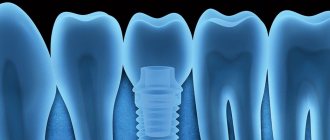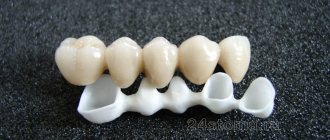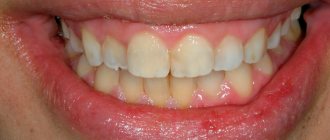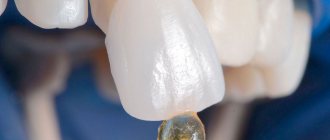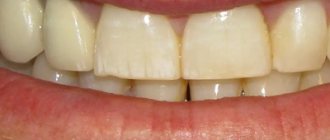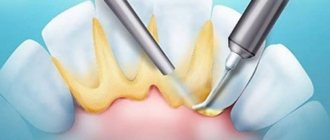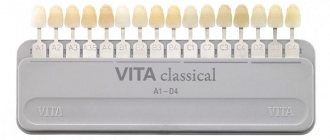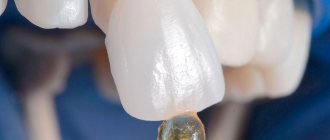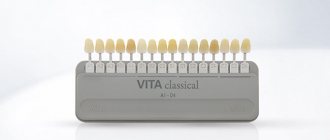Ceramic veneers are microprostheses for restoring the shape of a tooth and changing its color. They provide a long-lasting aesthetic effect that no other whitening method can provide. Due to their unlimited shelf life and high strength, they outperform composite materials used for dental restoration. At the same time, they are installed without traumatic treatment of the teeth, which cannot be avoided when using prosthetics with crowns.
Types of ceramic veneers
Based on the materials used for manufacturing, they are distinguished:
- Porcelain veneers made of pressed and unpressed ceramics. They have excellent aesthetics, adhere well to the teeth, but are not resistant to particularly heavy loads.
- Zirconium dioxide overlays. They consist of a zirconium frame on which a ceramic mass is applied. The material is extremely strong (stronger than metal), but has low adhesive properties (i.e., they are not securely fixed to the teeth).
Based on the thickness, microprostheses are divided into:
- ordinary (their thickness is 1.3-1.5 mm);
- ultranir (from 0.3 to 0.5 mm).
The best manufacturers
Microprostheses made from ceramics from the following manufacturers are widely used in aesthetic dentistry:
- E-max (German lithium silicate glass ceramics of increased strength);
- Empress (very thin and durable reinforced leucide glass ceramic, produced in Liechtenschnein);
- Finesse All Ceramic (American reinforced leucide glass ceramics);
- Cergo (German-made ceramics with a very smooth surface).
How to extend the service life
To ensure that microprostheses do not lose their properties and last as long as possible, it is important to properly care for them. By following simple recommendations, you can prevent premature darkening and damage to the integrity of the plates.
Rules for wearing aesthetic pads:
- minimizing foods and drinks containing acid - under its influence, the surface of microprostheses can be seriously damaged over time;
- avoidance of toothpastes containing coarse abrasive components and high pH levels;
- daily oral care - despite the fact that the plates cover the front part of the teeth and protect it from the accumulation of plaque and the development of caries, the inner surface of the enamel remains in danger; caries and periodontal disease can cause veneers to come off;
- reducing the daily intake of tea and coffee, avoiding coloring drinks and foods;
- exclusion from the diet of rough foods (seeds, nuts, carrots, etc.) - even the most durable microprosthesis cannot resist this factor;
- regular visits to the dentist’s office - even if visually everything is normal, a specialist may notice an exposed part of the tooth, the presence of cracks and abrasions on the plates.
"Hollywood" porcelain veneers
Special mention should be made of the so-called “Hollywood” veneers or lumineers (from the English luminary - luminary). These microprostheses have been decorating the smiles of American celebrities for 20 years now. Lumineers were once preferred by George Clooney, Tom Cruise, Angelina Jolie, Gwyneth Paltrow and other stars.
Lumineers are made from the strongest ceramics and are only 0.2-0.3 mm thick. The method of their production is patented and kept secret. These are the only microprosthetic onlays that are fixed to unground teeth.
Contraindications
Despite the versatility and practicality of the technique, there are limitations to the installation of veneers. For example, the use of plates is contraindicated in cases of bruxism, the presence of inflammatory processes, bone tissue pathology, and malocclusion.
Also, ceramic veneers are not used for the restoration of severely damaged teeth (more than 50%). In this case, the doctor installs crowns.
A refusal to carry out the procedure may be the presence of bad habits (biting nuts, nails, opening bottles with teeth, etc.). Or a high risk of maxillofacial injury. For example, extreme sports.
Gum disease and loss of chewing teeth will also require preliminary treatment before installing plates.
Manufacturing and installation
The entire process of prosthetic veneers takes about a week and involves two visits to the dentist.
How are veneers made?
Porcelain veneers can be made in two ways:
- layer-by-layer application and firing of porcelain mass (when working with unpressed ceramics);
- injection molding under the influence of high temperatures and pressure (this is how linings are made from pressed ceramics, which are considered more durable than those made from unpressed ceramics).
Microprostheses made of zirconium dioxide are manufactured using CAD/CAM technology:
- The CAD system creates a three-dimensional model of the overlay using a computer;
- The CAM system allows you to produce microprostheses according to a three-dimensional model on a highly accurate automatic milling machine (without human intervention).
The fastest way to automatically create a veneer from zirconium dioxide is to use the Cerec device (a set of technologies, equipment and materials for the production of ceramic microprostheses).
How are porcelain veneers installed?
Installation includes the following steps:
- Choice of color and type of overlay.
- Odontopreparation (removal of hard tooth tissues). To install conventional veneers and ultra-veneers, it is necessary to grind away from the tooth surface from half to one and a half millimeters. Lumineers are installed without grinding.
- Making an impression of the prepared tooth.
- Fixing a temporary plastic onlay (the ground tooth needs protection from the aggressive environment of the oral cavity while the onlay is being manufactured).
- Laboratory production of veneers based on impressions taken.
- Fastening the microprosthesis.
When installing lumineers, the second and fourth stages are omitted.
Composite: cheap, but not durable
First of all, the durability of veneers is affected by the materials from which they are made. Let's look at each of the varieties. So, composite. This is the most affordable and easy to implement option. You can install a composite crown in any dentistry; there are two ways of doing it:
- Aesthetic filling . Recommended for minor imperfections and slight changes in shade. To do this, part of the tooth is ground and covered with a thin layer of a special substance. This method is characterized by high efficiency of work execution (carried out in one day, without leaving the dental office). The downside is the increased fragility of the material.
- Laboratory production. A more complex and labor-intensive option: the doctor grinds the tooth, takes an impression and sends it to the laboratory. There, an expanded clay crown is made from it, which is subsequently fixed directly on the tooth. It allows you to hide significant flaws in the enamel, but it is also more expensive than the previous option.
Composite is the most affordable material for making veneers.
In any case, expanded clay is far from the most reliable material for making veneers. Not only is their surface easily stained when eating and drinking, gradually changing its tone. The service life of such crowns is not long: they usually last no longer than five years.
Important! Research conducted in 2004 showed that 2.5 years after the installation of expanded clay veneers, only 67% of people surveyed were satisfied with the result. Looking ahead, let's say that this is the minimum possible indicator.
Care
Ceramic veneers require the same care as natural teeth. To preserve their aesthetics and extend their service life, it is recommended:
- reduce the consumption of foods with dyes (the linings will not change color, but the fixing cement may);
- wear a plastic mouthguard for bruxism - pathological grinding of teeth;
- do not subject teeth with veneers to increased stress (do not bite ice, do not open bottles, do not bite nails and hair ends, do not shell seeds);
- Do not miss dental checkups (once every six months).
What it is?
Despite their ultra-thinness, the strength of the plates is comparable to the hardness of natural tooth enamel. The material allows you to repeat the shape of the tooth with maximum accuracy, hiding visible defects on its surface.
The demand for ceramic veneers is due to their practicality and full compatibility with the human body. The pads are non-toxic, do not cause allergic reactions, and do not require addiction. The translucent material is identical to natural tooth enamel. The shade scale allows you to select the color of the veneers that is similar to the shade of the patient’s teeth.
There are no problems with installing veneers: the plates are attached to the outside of the tooth using a dental compound.
Advantages and disadvantages
Advantages:
- high aesthetic effect (ceramics differs from composites in that it retains its original color and, with high-quality processing, is no different from a real tooth);
- biocompatibility (ceramic veneers are hypoallergenic);
- durability (compared to composite onlays, the short-term whitening effect and the five-year service life of a conventional filling);
- minimal or zero treatment of the tooth (the tooth is ground much more strongly for a crown).
Flaws:
- high cost (restoration with composite materials is cheaper);
- instability to heavy loads (can peel off and break);
- irreversibility of the preparation (the tooth ground under the veneer will no longer be able to function normally after the onlay is removed).
In what cases are plates installed?
The main purpose of onlays is to eliminate aesthetic defects on the front teeth. It can be:
- Chips and cracks.
- Previously installed fillings that have changed color or cracked.
- Interdental gaps and tooth pigmentation that cannot be eliminated by professional cleaning.
- Pathological abrasion of enamel.
In addition, ceramic veneers help correct minor changes in the bite, crooked teeth, and a decrease in the volume of gum tissue.
Manufacturers
To protect yourself from low-quality prosthetics, check with the clinic about what materials are used in the procedure. Mainly large companies specialize in the production of ceramic veneers. There aren't many of them.
The most famous company Nobel Biocare is a leader in implantology and prosthetics. It was this manufacturer that developed the popular protocols for implantation procedures All-on-4, All-on-6, Trefoil, etc. In the case of installing veneers, the company specializes in the production of zirconium plates.
The list includes German and Japanese companies that produce their products under the brands Katana, Prettau and BruxZir Anterior. The leader in the production of pressed and solid ceramics is Ivoclar Vivadent, which specializes in Emax technology.
Many years of experience, modern materials and strict quality control allow these companies to occupy a strong position in the dental materials market.
Diagnostics
The fixation of ceramic plates is carried out in three stages: preparation for the installation of veneers, production of the structure and fixation on the teeth.
Correctly performed diagnostics determines how long the orthopedic structure will serve the patient. In addition to the condition of the teeth, it is important to identify possible hidden pathologies in the bone and soft tissues of the jaw. And also carefully study the anatomical structure of the teeth being restored.
At EspaDent clinics, specialists conduct radiographic examinations for more accurate diagnosis. In complex cases, a modern 3D tomograph is used, which creates three-dimensional, layer-by-layer images of both jaws. During a consultation in our clinics, the doctor will offer the best options for microprostheses and immediately indicate the cost of the procedure.
